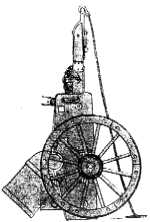|
| |||||||
| Coehorn Mortar | |||||||
| from "The Mortar" by WL Ruffell | |||||||
|
This Coehorn is designated 'mortar 4 2/5th inch' because mortars were designated by the diameter of the shell fired. Mortars did not fire shot. The Coehorn mortar illustrated is similar to those used by the New Zealand Armed Constabulary during the New Zealand Wars of the 1860s. To lay for line the layer stood behind the mortar with a plumb line in his hand and directed movement of the bed or mounting until the plumb line and the line of the center of the mortar were in line with the target. This method was still in use as recently as World War 1.
Mortars fired shell only. At first the firer ignited the fuze with a port-fire or linstock thrust down the barrel, then quickly fired the mortar itself, at the same time prayingn to St Barbara that the latter would not misfire! Tradition has it that in 1689 at the Siege of Limerick a Lieutenant Fireworker Brown 'in consequence of an accident' fired a mortar without lighting the fuze first - but found it functioned anyway, ignited by the flash from the propellant charge. Thus a Gunner hazard disappeared. By 1750 mortars had become standardised and limited to the following: 4 2/5th inch (Coehorn), 5.5-inch (Royal), 8-, 10-, and 13-inch in bronze and 8-, 10-, and 13-inch in cast iron. The Navy made use of the heavier 10- and 13-inch types in 'bomb' vessels. Except for size all bore a close resemblance to the Coehorn shown above and were still current equipment in some British colonies as recently as 1924! For use in the field the heavier pieces were mounted upon carriages.
Shown below is the sequence of coming into action for a 10-inch mortar. Prior to occupying a position a level platform was prepared.
|




